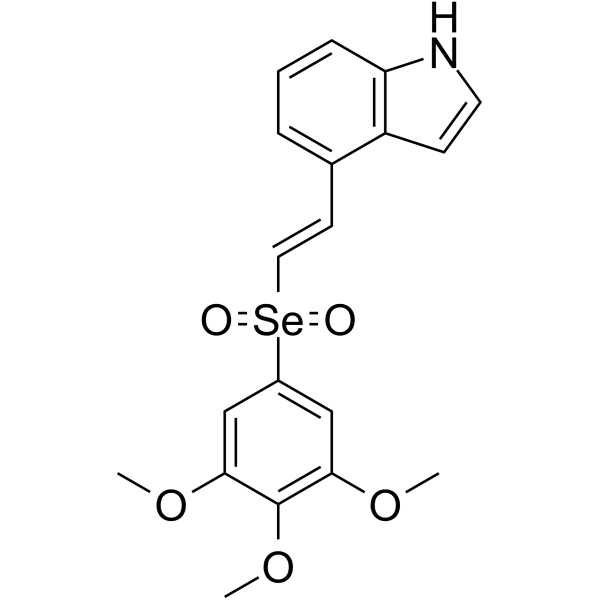| Description |
Tubulin polymerization-IN-9 is a potent tubulin inhibitor with IC50 of 1.82 μM. Tubulin polymerization-IN-9 causes cell cycle arrest at G2/M phase, and induces cell apoptosis and depolarized mitochondria of K562 cells. Tubulin polymerization-IN-9 has potent anti-vascular and antitumor activities[1].
|
| Related Catalog |
|
| Target |
IC50: 1.82 μM (tubulin)[1]
|
| In Vitro |
Tubulin polymerization-IN-9 (compound 11k) (0.1, 1, 10 μM; 72 hours) has potent activity against these three cancer cell lines with IC50 values ranging from 0.287 to 0.621 μM[1]. Tubulin polymerization-IN-9 (0.15, 0.3 and 0.6 μM; 24 hours) induces a dose-dependent collapse of the microtubule networks[1]. Tubulin polymerization-IN-9 (0.15, 0.3 and 0.6 μM; 48 hours) observes a gradual accumulation of cells at G2/M phase in K562 cells[1]. Tubulin polymerization-IN-9 (0.15, 0.3 and 0.6 μM; 72 hours) effectively induces cell apoptosis in K562 cells in a concentration-dependent manner[1]. Tubulin polymerization-IN-9 (0.15, 0.3 and 0.6 μM; 24 hours) causes mitochondrial depolarization of K562 cells in the process of apoptosis[1]. Cell Proliferation Assay Cell Line: K562 HepG2 and HCT-8 cells[1] Concentration: 0.1, 1, 10 μM Incubation Time: 72 hours Result: Showed potent activity against these three cancer cell lines with IC50 values ranging from 0.287 to 0.621 μM. Immunofluorescence Cell Line: K562 cells[1] Concentration: 0.15, 0.3 and 0.6 μM Incubation Time: 24 hours Result: Induced a dose-dependent collapse of the microtubule networks. Cell Cycle Analysis Cell Line: K562 cells[1] Concentration: 0.15, 0.3 and 0.6 μM Incubation Time: 48 hours Result: Observed a gradual accumulation of cells at G2/M phase in K562 cells. Apoptosis Analysis Cell Line: K562 cells[1] Concentration: 0.15, 0.3 and 0.6 μM Incubation Time: 72 hours Result: Effectively induced cell apoptosis in K562 cells in a concentration-dependent manner.
|
| In Vivo |
Tubulin polymerization-IN-9 (15 and 30 mg/kg; IV; once a day, for 21 days) effectively suppresses the tumor volume and reduces tumor weight by 71.1% at a dose of 30 mg/kg[1]. Animal Model: Male ICR mice (5 weeks; injected with H22 cells; n=6)[1] Dosage: 15 and 30 mg/kg Administration: IV; once a day, for 21 days Result: Effectively suppressed the tumor volume and reduced tumor weight by 71.1% at a dose of 30 mg/kg.
|
| References |
[1]. Zhu H, Sun H, Liu Y, et al. Design, synthesis and biological evaluation of vinyl selenone derivatives as novel microtubule polymerization inhibitors. Eur J Med Chem. 2020;207:112716.
|
